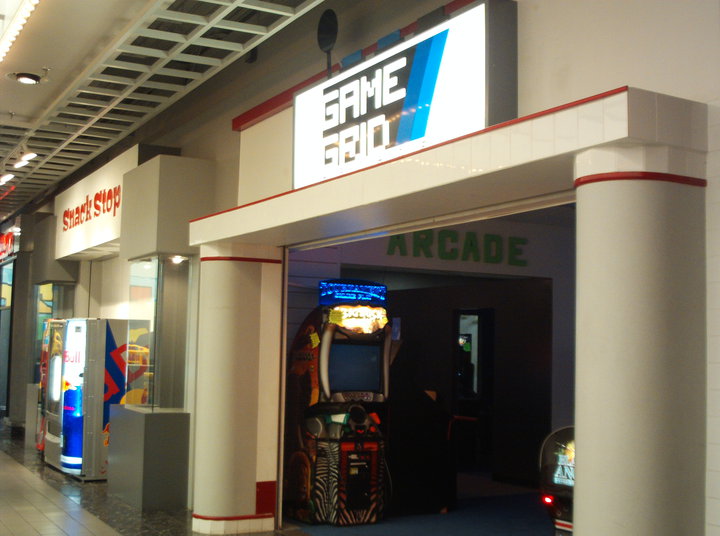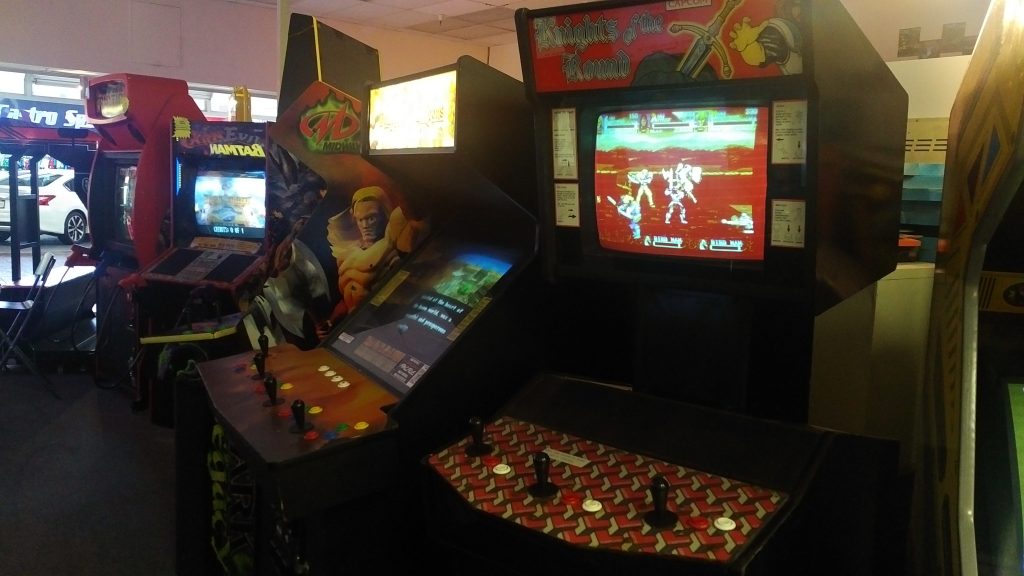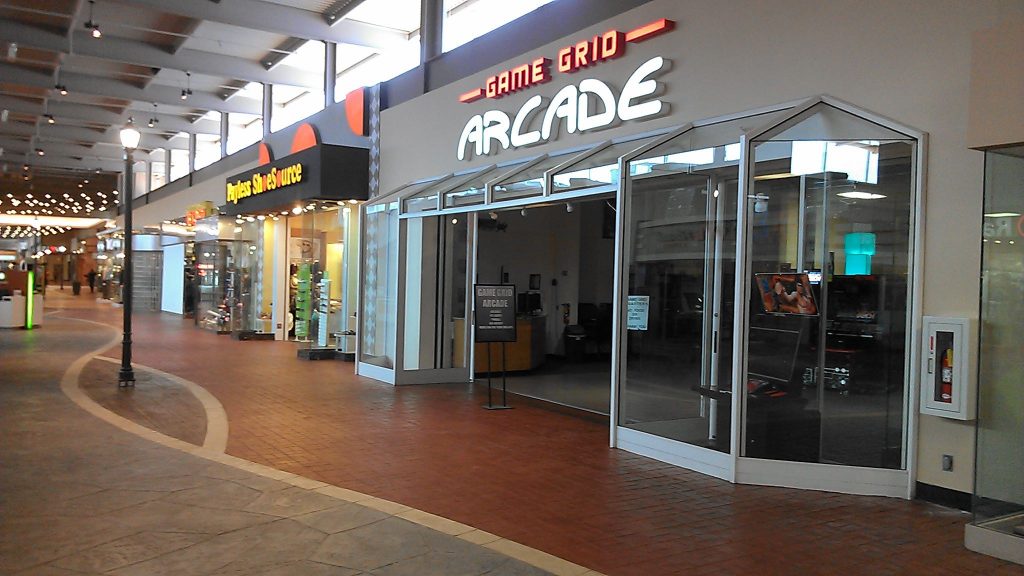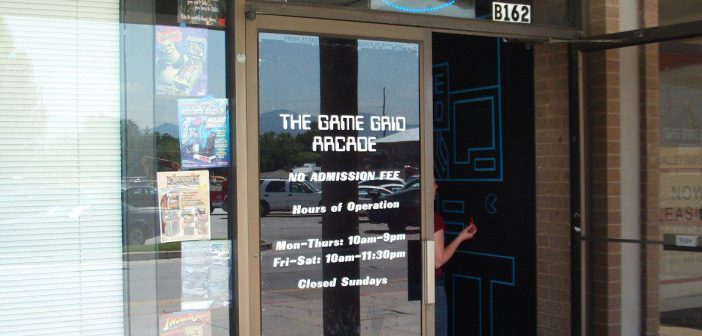 Achievement Unlocked
Achievement Unlocked
Celebrating 10 years in Business
by Adam Pratt, Game Grid Arcade & ArcadeHeroes.com
On June 8, 2008, I completed a step in a long journey. It was a quest that I had been preparing for since I was a child: to open my own arcade. Since I’m celebrating the 10th anniversary of that Game Grid Arcade, I thought I’d take readers along for the ride as I look back on how I started and made changes along the way.
Growing up, I took every opportunity I could get to play video games even though we didn’t have a lot of money at home. That meant my exposure to “cutting edge” stuff came by visiting a friend’s (or a friend of a friend’s) house. There was no arcade in walking distance of where I lived and while everyone I knew had an Atari 2600, the NES or the Sega Master System at home, I was “stuck” with my old TI 99/4A computer (which don’t get me wrong, I loved). My first real console came at the end of the ’80s, when my parents jumped on the opportunity of grabbing a low cost Atari 2600 Jr. and I was placated for a time.
I also had a little bit of an entrepreneurial knack. Instead of setting up a lemonade stand on my street like everyone else, I sold leftover items my dad would get from his work at the hospital. This meant items that held little to no interest to the kids on my block, such as cleaning rags and bags. While I rarely sold anything to the kids, I did alright in appealing to their parents (who were the ones with the money anyway).
Admittedly, I prefer passive selling to aggressive cold calling or knocking on doors. That, plus my aforementioned love of video games came together at some point and I became determined to run an arcade.
It’s difficult to recall the exact moment when I made the decision to be an arcade-focused entrepreneur, but it was likely during one my viewings of Disney’s TRON (1982). I discovered that movie through my first visit to a dark 1980s arcade when invited to a friend’s birthday party. That arcade was an incredible place to me, not requiring cartridges to play or rent, just a token to play some amazing looking games.
It was in that game room that I first stumbled across a Discs of TRON machine by Midway. For some odd reason, that machine stood out to me more than any other; I can still remember it while the rest of that visit is just a haze in my memory. I had no idea what TRON was at the time, but I wanted to find out.
It took a while, but I found the movie as a part of a TV broadcast and recorded it to VHS. The charismatic figure of Kevin Flynn seemed to have it all – he played games all day, made new ones in his spare time and was an “arcade hero” to his customers. That seemed like fun! I figured if I went that route, I would be involved in video games in some way. Cool!
My third job at an FEC during the laser tag/arcade era as a teenager helped boost this desire. As soon as I turned 18, I was promoted to management and got a taste of operations. This included managing employees, customer expectations, scheduling and even hiring. It was also around that time that I began to collect machines with the intention of using them in my future business. My first grab was a working 1942 (Capcom) and a broken Zaxxon (Sega). It wasn’t much but it was a start.
Game Grid 1.0
To make a long story shorter, I really kicked things into gear around 2006 when I began throwing a business plan together. I worked on that on and off, often during work breaks or down time at home in-between taking care of my first child. By the next year, I had a completed plan in hand. Our starter home had built up some equity that I would use as collateral for an SBA loan. By any industry standard, the amount would be laughed at as “chump change,” but combined with games I had collected and some small investments from my parents, aunt and uncle, grandfather and younger brother, it all came together to launch the Game Grid Arcade. The dream was coming true!
It did take me a little while to find a spot where the landlord was willing to give me the time of day. I heard many no’s along the way, and some scoffed at the very notion of an “arcade” coming into their precious strip mall.
After a few months, I ended up at a local mall with management that was easy to work with. Unfortunately, they shoved me into a “dead zone,” one of three empty storefronts on the outside of the mall. I had a Red Robin restaurant as my closest neighbor, but at least I had a space so I went about converting it into my business.
We started with about 25 games, mostly older titles that I was able to get at a discount from Mountain Coin. I was very fortunate that the sales guy on their staff at the time, Lydon Allred, was very receptive to my idea of a straight-up, traditional video arcade. Previously, I had spoken with sales people who brushed me off as soon as I said I had no interest in ticket redemption games, but Lydon was different. I was able to put together a fairly decent lineup of games and combined with a small network of gaming PCs, we were off to the races, so to speak.
That said, it was a difficult race to run. Our rent was unreasonably high and we weren’t making it work given the amount of foot traffic we were seeing. I had to work two other jobs to pay the bills at home, working those during the day and the arcade in the evening.
As for the customers, most wandered inside by accident, thinking it was an entrance to the mall. My vision of making the space look like a room from TRON didn’t help in that it was so dark that even with signage, people thought it was closed or too dark and seedy.
I did build a small and loyal user base with a LAN gaming room in part of my space, and much of that crowd would pop into the arcade when they were waiting for a turn. (We started with six computers, then added two more when those did better than expected. At our first location that helped us survive. When we moved to our third location, it quickly dropped back down to two…and then zero due to a number of factors.) Even with the LAN Gaming/computer income, to stay open I had to dip into a credit card plus beg the mall to lower my rent by $1,000 (which fortunately they did). Even so, foot traffic just wasn’t there and most of the marketing I was doing on social media was reaching people on the other side of the country, not from my local potential customer base.

Game Grid 2.0: The move to another “dead” part of the mall got us an inside entrance and more foot traffic. Though it was a smaller space, we were able to get enough good pieces into it to make it work, and ventured into the “black,” earnings wise, for the first time.
Game Grid 2.0
A little over a year after opening and by the hand of Providence, I was able to convince the mall to let us move inside. In part, the timing worked out as they were having a new big box retailer move in, and our spot was among those that would need to be demolished to make way for part of that store and to create a new entrance. Truth is, with earnings as low as they were at the time, we couldn’t have survived there for another month anyway. It was looking like the naysayers would be right, but I was still determined to prove them wrong. I just needed to obey that law of business: “location, location, location.”
The mall still put us into a dead zone, a hallway attached to the recently closed Mervyns building, but it was inside which meant that foot traffic was higher than on the outside. Also, the space was smaller so I had to get rid of a few giant pieces like my T-Mek (Atari). We were able to make things work and started seeing “black” on the earnings. It wasn’t a huge profit, but was just enough to pay all of the bills we’d accumulated.
It did get to a point where we could start adding some new games that I somehow managed to cram into the small, 1500-sq.-ft. space: Friction, Pac-Man Battle Royale, Super Street Fighter IV Arcade Edition, Dariusburst Another Chronicle and Terminator Salvation.

Game Grid 3.0: These fantasy games were among many we crammed into the small space. Thankfully, mall management was agreeable to letting us move to a larger location.
Game Grid 3.0
Things coasted along like this until the end of 2011 when news came along that a large local company had bought up the Mervyns space and would be taking over that entire wing of the mall to build a fancy new IMAX theater. Those of us in that hallway had to decide if we were staying or leaving. I elected to stay so I could finally get a chance to put the business into the main corridor of the mall. (It isn’t a large one by most standards – only one story tall and pretty basic for a layout.) The new space was larger than the previous two, with 2,000 square feet upfront, a wall in the center and almost 2,000 more square feet behind that. We could only partially fill up the front, but that was all we would need for awhile and we took it from there.
I wasn’t able to design the space the way I wanted to, having to fight with the management at the time over every little detail and having to spend a bit more money than I wanted to on things like high-end, expensive signage, a new front desk and so on. I’m still not quite sure how we managed it, but we did and our customers seemed to like it.
By this time, the LAN gaming network had lost steam (most only wanted to play Call Of Duty and after a while, people lost all interest in that, too) so we closed it down completely and put coin-op games in their place. As soon as the new theater opened at the end of 2012, business took off and we were able to continue adding games until about ’17 when I had 55 games crammed into the space.
Mall changes came along again and we lost that 2,000 square feet in the back to the installation of a Bed Bath & Beyond, but didn’t have to make any changes up front. We seemed to reach a peak in number of games, but it was so crowded on the floor that it was actually uncomfortable to stay and play.

Game Grid 4.0: The arcade’s current home where Pratt and company did much of the remodeling work themselves. Still no redemption equipment, but the arcade is profitable nonetheless and fills Adam Pratt with gratitude as he reflects on how his childhood passion turned into a profitable business supporting his family and others.
Game Grid 4.0
During these times, the mall management changed a few times, and the people who initially threw us outside moved on to other pastures. I’ve always tried to keep a good relationship in place with whoever was in charge of the facilities and with the current management, things have been good. Fortunately, they were open to the idea of letting us move to a larger space, so I set about doing so once again in January 2017.
I’ve written about the new space in these pages before, documenting the tasks of remodeling and the challenges that entailed. This time, there was little to no control over how we designed the space, although I had learned several lessons in interior design after three other locations.
We moved to our current location in May 2017 and business has never been better. The local economy has been resilient and strong, but even more so through these past two summers and the holiday season.
I still don’t operate ticket redemption, but do have a couple of operators who handle merchandisers and pinballs in my arcade. I’ve never been keen on managing those other machines and prizes, remaining a steadfastly loyal video game guy and for me, that works! Those other machines are solid earners in my arcade, but my video games routinely beat them out in earnings.
Lately I’ve spent way too much in adding new equipment to the arcade (we’ll have added five new games to the floor between February-May), but if you’ve been operating for a while, you know that you need fresh content –– games –– to keep cash flow up.
Thankful Indeed
With 10 years of being in business for myself under the belt, I’m filled with gratitude. I’m thankful for my wife and kids, who’ve been very patient with a dad who was always busy with something between two jobs; with extended family members who believed in me and invested; for friends who helped watch the store so I could take a couple of days off each year; and especially for my brother who has worked not just as an employee but also as a business partner.
I’m also very grateful to all of the people I have worked with in this industry – from those in game development and product manufacturing, the various distribution businesses, financing companies, technicians, fellow operators and executives, fellow journalists/industry reporters/bloggers, trade show organizers, game collectors and customers. I’m also grateful for the RePlay readers who’ve been along for part of the ride.
It’s been a tough but fantastic journey so far and I look forward to seeing what the future holds! If you’re ever in Salt Lake City, drop by and say hi!
Adam Pratt is the owner and operator of the Game Grid arcade near Salt Lake City, Utah. He also publishes the Arcade Heroes blog site and serves as an advisor for the web-based game supplier BMI Worldwide. He can be reached at shaggy@arcadeheroes.com.




